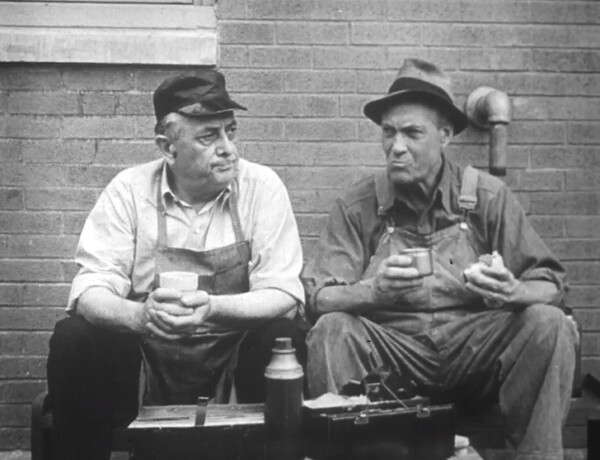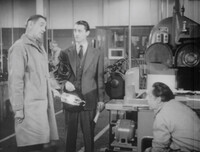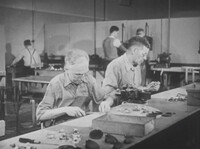The Era

Once a sign of challenging times in the 1930s, the employment offices of the 1940s would prove to have much higher rates of success in hiring.
To gain a full understanding of the economic conditions of the United States during World War II, one must begin all the way back in 1929. On October 24, 1929, the stock market crashed as Americans panicked and sold stocks in the fear of enlarging losses. The event would become known as Black Tuesday, and the effects of which would plummet the U.S. and the world into the Great Depression. Economic activities quickly halted throughout the country, resulting in mass unemployment, credit defaults, and a lack of credit. By 1932 the unemployment reached 31.4 percent as companies went under or downsided to stay alive.1 Fearful of bank shutdowns and in need of their savings, Americans demanded their cash out of banks which could not possibly satisfy every depositor’s demands and were forced to shutter.2 Agriculture faced additional economic pressures due to a prolonged drought throughout much of the Midwest, called the Dust Bowl or the “Dirty Thirties” due to the tendency for dry and loose soil to blow and form dust storms from a lack of water and proper soil conservation.3 Unfortunately the response to the crisis by President Hoover centered on fiscal tightening instead of spending money to spur economic activity. The 1932 election would bring President Franklin Delano Roosevelt, otherwise known as FDR, into office on the promise to better the economic struggles of Americans. Through massive new spending programs, President Roosevelt directed states and the federal government to create new spending projects, including help to create and expand the state and federal park system, documenting folklore and veteran graves, and even the commissioning of art and sculpture. Many of these were undertaken through the newly established Works Progress Administration, the Civilian Conservation Corps, and the Civil Works Administration. Furthermore, FDR formed many of the social service programs still available today, like Social Security and unemployment insurance. Even with such efforts, by the end of the decade the U.S. unemployment rate was still around 17 percent, and would linger until war production gains.4

Workers, who just a few years ago had difficulties in finding work, would be in short supply in the 1940s.
With a challenging employment environment, many segments of the population had limited economic prospects. Racial minorities, women, and people with disabilities were either almost non-existent in the job market or in lower pay positions. For women, societal expectations idealized traditional stay-at-home women. Due to lower income, minority women were frequently forced to do domestic dues in addition to picking up paid employment outside of the home.5 For many minorities, employment was limited to low wage and prestige sectors, frequently agriculture.6 Caused by Southern racism and the tough economic realities, African Americans increasingly embarked on what would be known as the Great Migration from the rural, often sharecropper life in the South to industrial cities in the North in the hope of finding higher paid jobs.7 People with disabilities were often entirely left out of the job market due to inaccurate societal beliefs about work abilities leading to employment discrimination.8 Further complicating work possibilities for people with disabilities was the leaving out of this group from most Great Depression era work programs; instead the federal government provided a low income to people with disabilities through social welfare programs whereas they could have otherwise likely earned more in the workforce.9 Overall, non-white Americans and those with disabilities faced particularly hard economic times throughout the Great Depression.
Work conditions in industrial settings were tough, as demonstrated in this scene from Placing the Right Man on the Job.
The effects of the Great Depression were still lingering when hostilities in Europe started what would become World War II. While America initially remained out of the conflict when it began on September 1, 1939, with Germany's invasion of Poland, the U.S. would soon start supporting the Allies by supplying them with food and war materiel through the Lend-Lease Act.10 U.S. entrance into the war, sparked by the Japanese surprise attack on Pearl Harbor on December 7, 1941, soon found millions of American soldiers battling through three continents to secure victory against the Axis powers. The manpower required to secure victory was enormous, with estimates of around 10,500,000 soldiers in total serving for the U.S. military.11 The need to supply millions of soldiers with everything from food, bullets, and medical supplies would reinvigorate the U.S. economy after years of poor performance within the Great Depression. The fighting would not come to an end until September of 1945, with the surrender of Japan.
U.S. involvement in the war created new realities for life on the American homefront. With the drafting of service age men into the military, the U.S. turned to new sources of labor to fill the demands of wartime industry. These new sources included women, individuals with disabilities, minorities, and migrants from other countries that were previously socially excluded from or limited in the labor pool.12 Sources, like the Problems in Supervision series, served as educational materials for supervisors and managers trying to adjust to new workforce realities. The war years brought massive gains in employment numbers, but new workers in the economy had to fear the longevity of their situations as progress in the war effort grew.13 The end of hostilities would bring about a cooling period in job growth due to a pullback in government spending coupled with the sudden return of millions of soldiers who went off to war with the promise of regaining their previous jobs on their arrival back home.14 Many of these soldiers in need of employment would themselves come back home with war-related disabilities, with some estimates going as high as 500,000 returning soldiers.15 Increased competition for jobs with returning veterans risked other segments of the labor force to leave the higher paying positions or the workforce entirely, potentially reverting many of the gains experienced by wartime workers.

The ability to integrate new sources of labor to the industrial setting would be key to achieving production goals. Skills like interpreting the details of blueprints were likely a common topic.

For good and bad, new work realities would see large portions of the population interacting with machines on a regular basis.


